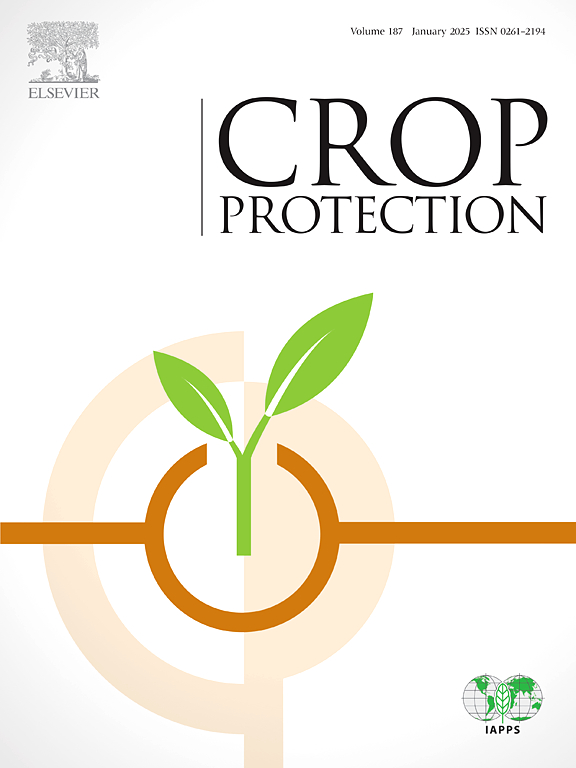氧化苦参碱类生物农药对花生红蜘蛛螨的杀螨活性及药效研究
IF 2.5
2区 农林科学
Q1 AGRONOMY
引用次数: 0
摘要
在室内、半田间和田间条件下,评价了氧化苦素类商品生物农药对1997年花生赤蜘蛛螨的杀螨活性和杀螨效果。在实验室中,以氧化苦藤碱为基础的生物农药对臭毛螨幼虫、原幼螨、双染螨和成年雌螨具有较高的急性毒性,其毒性程度取决于螨虫的浓度、发育阶段和暴露于残留物的时间。在不同发育阶段,异色螨幼虫对生物农药的敏感性高于成虫。该生物农药还能降低昆虫的繁殖力和育性,诱导较低的杀卵效果,并具有较高的驱避活性。在半田间试验中,与合成杀螨剂甲氰菊酯相比,该生物农药具有较短的生物持久性[在喷洒后1天内死亡率为80%](DAS),在喷洒后3天内死亡率为80%)。在7和10 DAS时,与对照相比,施用生物农药的花生植株上未观察到明显的螨虫死亡率。然而,合成杀螨剂甲氰菊酯的死亡率高达40%至10das。在田间试验中,生物农药对螨的控制效果较好,与合成杀螨剂甲氰菊酯的控制效果相当。因此,氧化苦参碱类生物农药可与合成杀螨剂轮作使用,作为常规花生作物中抑虫或有机花生作物中防治花生红蜘蛛螨的有效措施。本文章由计算机程序翻译,如有差异,请以英文原文为准。
Acaricidal activity and efficacy of oxymatrine-based biopesticide against peanut red spider mite
The acaricidal activity and efficacy of oxymatrine-based commercial biopesticide on the peanut red spider mite Tetranychus ogmophallos Ferreira and Flechtmann, 1997 were assessed under laboratory, semi-field, and field conditions. In the laboratory, the oxymatrine-based biopesticide provided high acute toxicity for T. ogmophallos larvae, protonymphs, deutonymphs, and adult females, in a manner dependent on the concentration, developmental stage, and exposure time of mites to residues. Among the mite developmental stages, T. ogmophallos larvae were more susceptible to the biopesticide than adult females. The biopesticide also reduced fecundity and fertility, induced a low ovicidal effect, and provided a high repellent activity against T. ogmophallos. In semi-field, the biopesticide showed a short biological persistence [mortality >80% up to 1 day after spraying (DAS)] compared to the synthetic acaricide fenpropathrin (mortality >80% up to 3 DAS). At 7 and 10 DAS, no significant mite mortality was observed on peanut plants treated with biopesticide compared to the control. However, the synthetic acaricide fenpropathrin caused mortality greater than 40% up to 10 DAS. In the field, the biopesticide showed high effectiveness in controlling the mite population, with a similar efficacy to the synthetic acaricide fenpropathrin. Therefore, the oxymatrine-based biopesticide constitutes an important management tool to be used in rotation with synthetic acaricides for population suppression of T. ogmophallos in conventional peanut crops or as an effective measure for controlling peanut red spider mite in organic peanut crops.
求助全文
通过发布文献求助,成功后即可免费获取论文全文。
去求助
来源期刊

Crop Protection
农林科学-农艺学
CiteScore
6.10
自引率
3.60%
发文量
200
审稿时长
29 days
期刊介绍:
The Editors of Crop Protection especially welcome papers describing an interdisciplinary approach showing how different control strategies can be integrated into practical pest management programs, covering high and low input agricultural systems worldwide. Crop Protection particularly emphasizes the practical aspects of control in the field and for protected crops, and includes work which may lead in the near future to more effective control. The journal does not duplicate the many existing excellent biological science journals, which deal mainly with the more fundamental aspects of plant pathology, applied zoology and weed science. Crop Protection covers all practical aspects of pest, disease and weed control, including the following topics:
-Abiotic damage-
Agronomic control methods-
Assessment of pest and disease damage-
Molecular methods for the detection and assessment of pests and diseases-
Biological control-
Biorational pesticides-
Control of animal pests of world crops-
Control of diseases of crop plants caused by microorganisms-
Control of weeds and integrated management-
Economic considerations-
Effects of plant growth regulators-
Environmental benefits of reduced pesticide use-
Environmental effects of pesticides-
Epidemiology of pests and diseases in relation to control-
GM Crops, and genetic engineering applications-
Importance and control of postharvest crop losses-
Integrated control-
Interrelationships and compatibility among different control strategies-
Invasive species as they relate to implications for crop protection-
Pesticide application methods-
Pest management-
Phytobiomes for pest and disease control-
Resistance management-
Sampling and monitoring schemes for diseases, nematodes, pests and weeds.
 求助内容:
求助内容: 应助结果提醒方式:
应助结果提醒方式:


